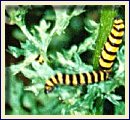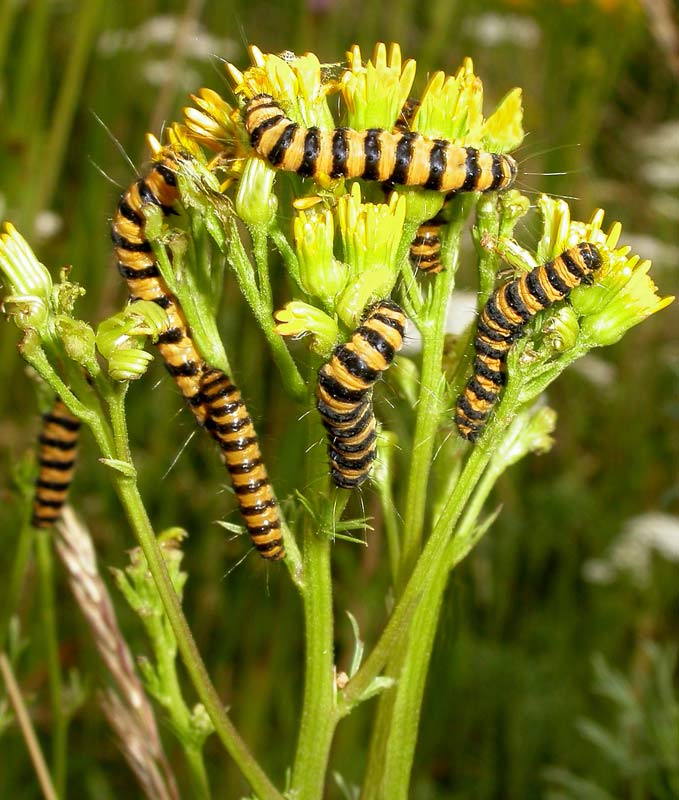Tyria jacobaeae Insect: moth (Lepidoptera : Arctiidae) 

Common Name: Cinnabar moth (1-3)Description: Tyria jacobaeae have black forewings with a red stripe on the outside of the forewing and have a complete red hindwing with a black stripe on the outside. With their wings closed, they are about 20 millimeters long (2).
Origin: France (1)
Life Cycle:
Overwintering State: During the pupil stage (1), usually in debris or under rocks (3). Many pupas can be lost because the pupa cannot be in water for long periods of time (2).
Egg Stage: The eggs are laid on the bottom side of the ragwort leaves (2) during spring and midsummer (1). Eggs turn from yellow to a pearly-gray previous to hatching. They are about 1 mm in diameter. They are laid in groups of 30-60. (5)
Larval Stage: The larvae hatch about two weeks after the eggs are laid and eat the old eggs (2) and the bottom of the leaf until they work their way up to the top of the tansy ragwort (1). Once they have eaten all of one plant, they will move up to 800 meters to find more ragwort (3). Most larvae are about 2.5 centimeters long, have yellow and black bands, and live in groups of 10 to 30 (1).
Pupil Stage: The pupil stage lasts for about nine months (2), where they stay under rocks, bark, or debris. The pupae are about 20 to 25 millimeters long and are dark brown (1,3). They can lose up to thirty-three percent of their body weight during this stage before they die (3).
Adult Stage: Tyria jacobaeae lay up to 300 eggs per female (3) two weeks after they come out (1). They fly during the day and are attracted to light (1).
Photos of adult moths:
http://ukmoths.org.uk/show.php?bf=2069
http://www.flickr.com/photos/jvk/491066572/
http://www-staff.it.uts.edu.au/~don/larvae/arct/jacob.html
Damage to Host: Damage is done during the larval stage on the tansy ragwort. They feed on the leaves and the flowers, leaving only the defoliated stem (1).
Host Impact: The moth works best when they are used with Longitarsus jacobaeae, which helps to prevent seed production (1).
Release Habitats: Tyria jacobaeae does best at an elevation of less than 1,000 meters with warm and sunny conditions. They do well to the west of the Cascade Mountains, but do not do well in canyons, under trees, in other shady areas (1) or in moist environments. (7)
How and Where to Collect, Transport, and Release: To collect larvae, shake the plants into a paper bag or a cooler, preferably a styrofoam cooler. Put fresh plants in with the moth larvae for food, moisture and to keep them from getting out while they are being moved. For adults, you can put them in a paper cup that is covered with paper inside to keep their wings protected. If the moth is kept cool, the adults can be stored for about a week. During the larval stage is the best time to collect Tyria jacobaeae (1).
How to Redistribute: You can collect about 500-1000 to release at a new site. Try not to release the insect where there are many ants or flooding (3). Be sure and understand the ecological needs of the insect so you can release them in a good spot.
Where and How to Purchase: Contact county weed coordinator or county agent.
Remarks: Tyria jacobaeae contain toxic alkaloids, therefore they are red and black as a warning to other animals. The larvae must have plenty of food and they need much care. Keep them away from ants, they can kill the larvae (1). "These insects are working very well in some areas of Montana" -Todd Breitenfeldt
Links:
1. Pictures and Information on Tyria jacobaeae
2. Pictures of Tyria jacobaeae
3. BioImages of Tyria jacobaeae
4. Lethbridge Research Centre
5. HortFACT
6. Tyria jacobaeae
7. Information about Tyria jacobaeae
8. Australian Caterpillars
9. Image of Tyria jacobaeae
10. Close Up Picture of Tyria jacobaeae
Literature Cited:1.) Rees, Norman, et. al., Ed., Biological Control of Weeds in the West, Western Society of Weeds Science, in Cooperation With USDA ARS, Mt Department of Ag, and MT State Univ., Color World Printers, Bozeman Mt, Feb., 1996.
2.) Dr. John Ireson, Senior Entomologist, Tasmanian Institute of Agricultural Research, Cinnabar Moth [Online] Available: http://www.microtech.com.au/mvws/cinn.htm, 1999.
3.) Harris, Peter. Tyria jacobaeae L. (Cinnabar moth). Defoliator. Agriculture and Agri-Foods Canada. Internet. 4 Jan. 2002. Available: http://res2.agr.ca/lethbridge/weedbio/agents/atyrjac.htm.
By: Jenelle Hanson 01/09/02
Updated by: Brandon Smith and Evan Lewton 01/30/08
Back to Biological Control mtwow.org HOME